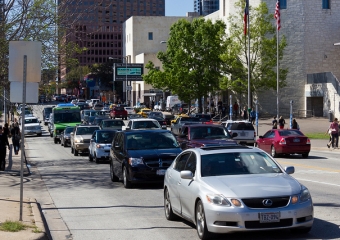
Traffic congestion – is anything more frustrating? Time is wasted. Stress levels rise. Motorists are in danger when emergencies occur. Drivers become erratic. Something must be done!
With inadequate transportation funding, cities and states throughout the United States are searching for solutions. One of the latest trends is a “smart” traffic signal system. Some cities adopted this technology early. Others are just beginning to use it.
The innovative transportation technology can be used in various ways, but one of the more common uses is to adjust signal light timing to traffic flow. In other words, lights turn green when there is no traffic approaching from another direction. And, lights stay green longer when there is an abundance of traffic from one direction and not the other.
Traffic lights, in smart systems, are tied to software that makes adjustments without manual assistance. There are a number of ways that signals are sent. For instance, inductive wire can be imbedded in the highway pavement or cameras can be used. Radar is another option and there are others.
One of the more common uses of smart traffic signal technology is to automate traffic lights when fire trucks, ambulances and other emergency vehicles are detected. When this happens, lights switch to green to provide access for emergency vehicles through intersections. The lights will then stay green for whatever period of time it takes for the vehicles to pass without having to stop or slow down. Not only does the technology allow emergency vehicles to reach destinations faster, but it also affects safety. The city of Plano, using this technology, reduced the number of emergency vehicle accidents from 2.3 per year at intersections annually to less than one every five years.
Earlier this month, Pittsburgh began installing smart traffic signal software at 130 intersections. Next year, Palm Beach County and the Florida Department of Transportation plan to install the systems at six intersections. California and Utah both are heavily invested and Los Angeles has the highest concentration of adaptive signals in the country. Eighty percent of the state’s traffic signals are smart signal systems in Utah and Oakland County, Michigan, has the second largest adaptive signals system in the United States.
The city of Bellevue, Washington, began implementing smart or “adaptive” signals almost five years ago and its systems are quite sophisticated. For instance, the city has different cycle lengths for traffic lights at different times of the day. City officials hope to have all 197 city intersections switched to smart signals by the end of this year. Officials say their $5.5 million investment will save drivers $9 million to $12 million a year in lost time.
A Texas A&M Transportation Institute report estimated that in 2020, delays caused by traffic congestion in this country will reach 8.4 billion hours, resulting in the average commuter losing 45 hours and 25 gallons of gas. The carbon dioxide emissions that result from idling vehicles are not only detrimental to the area, but to the entire planet.This is only one solution that is gaining traction as public officials seek to find ways to reduce traffic congestion. Others are being implemented as well. Innovation is good!
As the United States finds more innovative ways to improve our transportation infrastructure, ensure that your business is involved and let SPI help you win government business.

